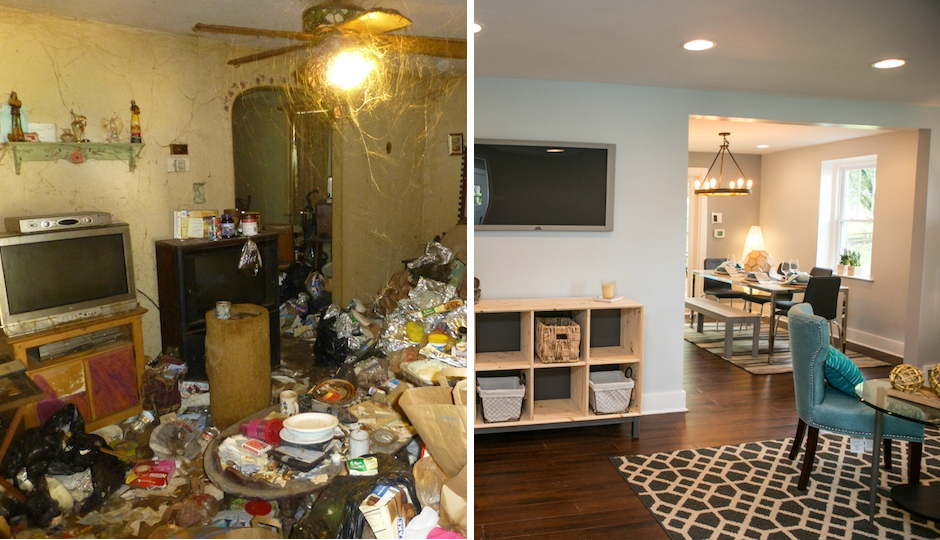From Trash to Treasure: The Story of the Ugliest House in America

HomeVestors franchisee Tom Beerley turned this ugly duckling in Springfield into a swan. | Before photos: Tom Beerley via HomeVestors; after photos: Pravada Photography via HomeVestors
You’ve seen those big yellow billboards that proclaim “We Buy Ugly Houses,” right?
Those are the work of HomeVestors, a company that franchises its services to investors who would like to help owners of properties in distress.
Each year, the company sponsors a competition among its franchisees to identify the “Ugliest House in America” as a way of showcasing the work HomeVestors buyers do.
And “showcase” is precisely what the 2016 Ugliest House in America, a two-story home built in 1945 in Springfield, Delaware County, became thanks to the efforts of franchisee Tom Beerley.
The home could hardly have been more distressed. Nor could its owner.
“A concerned neighbor was trying to help the homeowner,” he said, and the neighbor contacted him in response to one of those HomeVestors ads. “We came out to look at the house a couple of times before we bought it. When I first went out to look at it, the homeowner was reluctant to even let me inside, which was understandable. I was reassuring and understanding of her situation and how she felt about how the place looks.”
It got to look that way thanks to a series of unfortunate events. The homeowner had fallen behind on her property tax payments, and as a result, the township ceased to pick up her trash. That led her to keep all the debris inside the home. Then, on top of that, the home’s plumbing developed leaks, and since she could not afford to fix them, she had the water service shut off. By the time that happened, the leaky pipes had ruined the ceilings in a number of places, leaving beams and framing exposed.
“She was doing her best to live in the house, but it was increasingly difficult,” Beerley said.
By the time he arrived on the scene, the house was about to be auctioned off for back taxes. “We bought the house on less than 30 day’s notice,” he said. “If we hadn’t, she would have been evicted. Instead, we put money in her pocket and helped her transition to an apartment.”
That was the easy part. Then came the cleanup and restoration.
“There was a much greater volume of stuff in the house than I’m used to dealing with,” he said. “We filled five 40-yard dumpsters in the course of cleaning it out.”
But once it was cleaned out, he could turn to remodeling it. For that job, he partnered with a startup firm that was working on another home he had purchased in Northeast Philadelphia. That firm, founded by local builder/designer Philip Menaged, is now a regular partner on Beerley’s projects.
“It was a difficult project – a full gut,” Beerley said. “We replaced the electrical and plumbing systems, installed a new roof, took out some interior walls and finished the basement.” In all, Beerley poured $145,000 into the renovations.
“We turned a one-bath house into a home with three full baths, and it turned out beautifully. When it sold, it set a record for the neighborhood in terms of appraisal, we had done such a nice job.” (Take a look at the photos below and see if you agree.) The house ultimately sold for $350,000, well above the neighborhood median.
Beerley launched his HomeVestors franchise, Harvester Properties, Inc., in 2012, when he was still working as a software architect at Microsoft. The constant travel got to him, so he decided he would turn his interest in fixing up properties into a career. As he was studying for his real estate license, he saw an ad for HomeVestors, did some research into the company, and decided it would mesh well with his own goals, which was to buy fixer-uppers, restore them, sell some and keep others as rentals.
It’s a common business model for most HomeVestors franchisees, and it enables them to both do well and do good for homeowners in trouble at the same time.
“Tom is a great example of what HomeVestors is all about. Not only did he turn an ugly house into a beautiful home, but like every franchisee, he genuinely cares about his homeowners and their safe living conditions,” David Hicks, co-president of HomeVestors of America, said in a news release.
“For me, this is my proudest achievement to date,” Beerley said.
Follow Sandy Smith on Twitter.
Updated Feb. 15, 8:52 p.m., to correct the cost figure for the reconstruction and the name of Beerley’s company.


